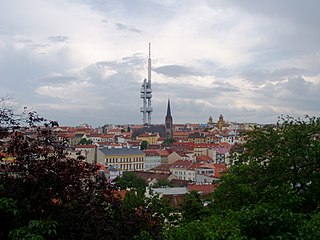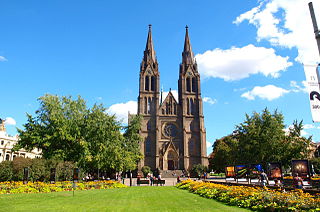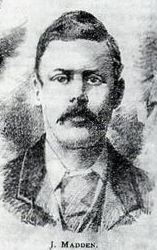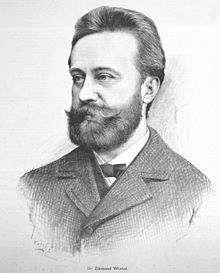
The Vltava is the longest river in the Czech Republic, running southeast along the Bohemian Forest and then north across Bohemia, through Český Krumlov, České Budějovice, and Prague, and finally merging with the Elbe at Mělník. It is commonly referred to as the "Czech national river".

Julius Ernest Wilhelm Fučík was a Czech composer and conductor of military bands. He became a prolific composer, with over 400 marches, polkas, and waltzes to his name. As most of his works were for military bands, he is sometimes known as the "Bohemian Sousa".

Žižkov is a cadastral district of Prague, Czech Republic.

Vinohrady is a cadastral district in Prague. It is so named because the area was once covered in vineyards dating from the 14th century. Vinohrady lies in the municipal and administrative districts of Prague 2, Prague 3 and Prague 10, little parts also of Prague 1 and Prague 4.

Prague 2, formally the Prague 2 Municipal District, is a second-tier municipality in Prague. It is co-extensive with the national administrative district of the same name.

Prague 3, is a second-tier municipality in Prague. It is geographically identical to the national administrative district and city administrative district of the same name.

Viktor Dyk was a nationalist Czech poet, prose writer, playwright, politician and political writer. He was sent to jail during the First World War for opposing the Austro-Hungarian empire. He was one of the signatories of the Manifesto of Czech writers. Dyk co-founded a political party and entered politics. He died at age 53, leaving his many poems, plays and writings.

Karel Václav Rais was a Czech realist novelist, author of the so-called country prose, numerous books for youth and children, and several poems.

Vlastimil Kopecký was a Czech football player. He played 26 games for Czechoslovakia, scoring eight goals. He was a participant in the 1934 and 1938 FIFA World Cups.

Otto Gutfreund also written Oto Gutfreund, was a Czechoslovak sculptor. After studying art in Prague and Paris, he became known in the 1910s for his sculptures in a cubist style. After his service in the First World War he worked in a more realistic style. His later work includes many small polychrome ceramic figures as well as architectural decorations.

John William Madden was a Scottish footballer who played for Dumbarton, Gainsborough Trinity, Grimsby Town, Celtic, Dundee, Tottenham Hotspur and the Scotland national team.
Czechs in Omaha, Nebraska have made significant contributions to the political, social and cultural development of the city since the first immigrants arrived in 1868.

Ladislav Jan Šaloun was a Czech sculptor of the Art Nouveau period.

Jiřina Štěpničková was a Czech actress. She spent 10 years in prison for an attempt to illegally cross a border.

Vršovice is a cadastral district of Prague. All of Vršovice lies within the Prague 10 administrative district. Vršovice is located south-east of the city centre. It borders Vinohrady to the north, Nusle to the south-west, Michle to the south and Strašnice to the east. The name is first mentioned in 1088 in the founding document of the Vyšehrad Chapter. In 1922 the district was incorporated into the city of Prague. It has 107 streets and 1,611 addresses and has about 38,700 inhabitants.

Strašnice Crematorium is the largest crematory in Europe in terms of area. President Václav Havel was cremated here. The crematorium was involved in the disposal of those who had been executed by the Nazi and Communist regimes including writer Vladislav Vančura, general Josef Mašín, politician Milada Horáková and bishop Gorazd of Prague.

Vinohrady Water Tower is a building in Vinohrady in Prague 10 which was originally built as a water tower. Today its architecture is recognized as culturally important although it is now converted to accommodate offices and apartments. The viewing platform at the top is 40 metres above the street level. Its tourism helps pay for over 20,000 dollars worth of repairs and maintenance a year.

Strašnice is a cadastral district in Prague. It became part of Prague on 1 January 1922. It lies mostly in the municipal and administrative district of Prague 10 while a small part is in Prague 3. The district is bordered by Vršovice, Vinohrady, Žižkov, Malešice, Hostivař, Záběhlice and Michle.

Vinohrady Cemetery is a large cemetery in Vinohrady in Prague 10 which contains Strašnice Crematorium. It is the second largest cemetery in Prague and is registered in the state list of cultural monuments. The remains of two Czech presidents are in this cemetery.

Jan Nepomuk Woldřich was a Czech-Austrian geologist, paleontologist and amateur archaeologist. He served as a professor at the Czech Charles-Ferdinand University in Prague.



















